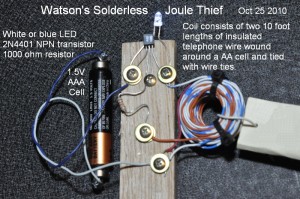 I took this photo just before Halloween back in 2010, after I made this Joule Thief without solder and without a toroid. It shows that you don’t have to know how to solder and you don’t have to have a toroid to make a working Joule Thief – all you need is a screwdriver. So do your thing and experiment a bit, and see what you can come up with.
I took this photo just before Halloween back in 2010, after I made this Joule Thief without solder and without a toroid. It shows that you don’t have to know how to solder and you don’t have to have a toroid to make a working Joule Thief – all you need is a screwdriver. So do your thing and experiment a bit, and see what you can come up with.
Each screw (except for one) has two washers to hold the wires. Putting two or more wires under the screw head without the washers will be difficult and the wires will try to come loose. Two or three washers makes it easier and the wires are held much firmer. The wood block is a piece of solid oak that is about a half inch (12mm) thick. The oak is very hard and the screw holes have to be drilled out before the screws are put in. This also makes it possible to use small screws with a flat end which were used for holding plastic parts together. The screw size is about #3 by 3/8 inch long, with coarse threads like a sheet metal screw.
The LED is not very bright because it’s a cheap 3 mm white LED I got from an eBay seller, and it has been used a bit so it has dimmed. Use a decent LED and this circuit will be as bright as a toroid JT.
 Another Joule Thief I put together is shown in the second photo. This uses the bare wires to wrap around the joints in place of solder. The joints are not as mechanically strong as solder but for a quick experiment they should work okay. If the JT is going to be used, the wire joints may become intermittent or loose. The solder joints are a much better connection.
Another Joule Thief I put together is shown in the second photo. This uses the bare wires to wrap around the joints in place of solder. The joints are not as mechanically strong as solder but for a quick experiment they should work okay. If the JT is going to be used, the wire joints may become intermittent or loose. The solder joints are a much better connection.